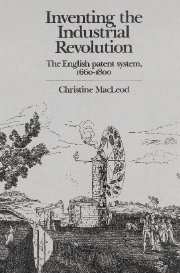Book contents
- Frontmatter
- Contents
- List of tables and figure
- Acknowledgements
- List of abbreviations
- Notes on style
- Introduction
- 1 Patents 1550–1660: law, policy and controversy
- 2 The later-Stuart patent grant – an instrument of policy?
- 3 The development of the patent system, 1660–1800
- 4 The judiciary and the enforcement of patent rights
- 5 The decision to patent
- 6 Invention outside the patent system
- 7 Patents in a capitalist economy
- 8 The long-term rise in patents
- 9 The goals of invention
- 10 Patents: criticisms and alternatives
- 11 A new concept of invention
- Notes
- Bibliography
- Index
10 - Patents: criticisms and alternatives
Published online by Cambridge University Press: 28 October 2009
- Frontmatter
- Contents
- List of tables and figure
- Acknowledgements
- List of abbreviations
- Notes on style
- Introduction
- 1 Patents 1550–1660: law, policy and controversy
- 2 The later-Stuart patent grant – an instrument of policy?
- 3 The development of the patent system, 1660–1800
- 4 The judiciary and the enforcement of patent rights
- 5 The decision to patent
- 6 Invention outside the patent system
- 7 Patents in a capitalist economy
- 8 The long-term rise in patents
- 9 The goals of invention
- 10 Patents: criticisms and alternatives
- 11 A new concept of invention
- Notes
- Bibliography
- Index
Summary
Before the mid-eighteenth century the question of how best to promote invention was rarely discussed with reference to the patent system. Likewise, on those few occasions when any writer thought fit to mention the patent system it was unusual for it to be in the context of stimulating inventive activity. Patents were still regarded, first and foremost, as monopolies. The close association of letters patent with Court patronage until the end of the seventeenth century (and the range of grants for which they were used) defined them principally as instruments of the royal prerogative; the stigma lingered. When the patent ‘system’ was discussed it was usually as an established institution: given its existence, was it either ethical or costeffective to use it? There were few proposals for its reform before the 1780s, and explicit calls for its abolition were a rarity before the mid-nineteenth century (when free-traders launched a noisy attack). Among those who sought a means of stimulating technological development it was largely ignored. Since in the seventeenth century such concerns were confined principally to members of the Hartlib circle, who were politically at variance with the Stuart Court, it is unsurprising that they looked beyond patents. When interest was revived a century later, there was as much desire to promote the diffusion of extant best practices as to prompt inventive activity. The patent system, which at that time made virtually no demand on the inventor to reveal his secrets, tended to be dismissed without a second thought; other means of rewarding innovation were proposed.
- Type
- Chapter
- Information
- Inventing the Industrial RevolutionThe English Patent System, 1660–1800, pp. 182 - 200Publisher: Cambridge University PressPrint publication year: 1988



